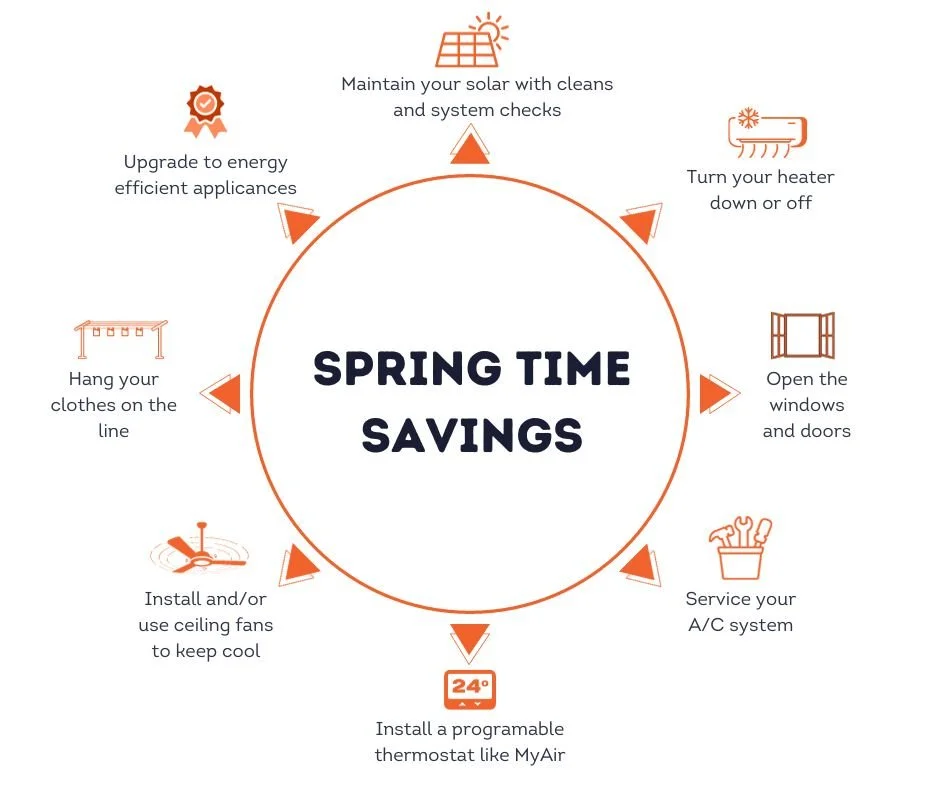Reducing energy consumption in the springtime is not only good for your wallet but also for the environment. Here are some tips to help you save energy during the spring season:
Adjust Your Thermostat: Spring often brings milder temperatures. Take advantage of this by lowering your thermostat to a comfortable but cooler setting. You may not need as much heating as you did in the winter. You might even be able to turn it off altogether.
Use Natural Ventilation: Open windows and doors to let in fresh air during the daytime when it's mild. This can help reduce the need for air conditioning and improve indoor air quality.
Hang Clothes Outside: Take advantage of the warmer weather to dry your clothes outside instead of using a dryer. It's energy-free and can also make your clothes smell fresh.
Maintain your solar system: Keeping the panels clean and free from pollen and dust is essential to optimising the performance of your system (check out ECG+ as we can take care of this for you).
Maintain Your HVAC System: Spring is a good time to have your heating, ventilation, and air conditioning (HVAC) system serviced. Clean or replace filters, check for leaks, and ensure the system is running efficiently.
Install a Programmable Thermostat: A programmable thermostat allows you to set specific temperature settings for different times of the day. You can program it to adjust the temperature when you're not home or when you're sleeping, which can lead to significant energy savings.
Seal Leaks and Insulate: Check for drafts around windows and doors and seal any gaps or leaks. Proper insulation can help maintain a comfortable temperature inside your home, reducing the need for heating and cooling.
Utilize Ceiling Fans: Use ceiling fans to circulate air. In the spring, you can set them to rotate counterclockwise to create a cooling effect.
Reduce Water Heater Temperature: Lower the temperature of your water heater to 120°F (49°C). This can save energy and reduce the risk of scalding.
Switch to LED Lighting: Replace incandescent and CFL bulbs with energy-efficient LED bulbs. They use less energy and last longer.
Unplug Electronics: Many electronic devices continue to consume energy even when turned off. Unplug chargers, computers, and other devices when they're not in use, or use smart power strips to cut off power completely.
Plant Trees and Shrubs: Planting trees and shrubs strategically around your home can provide natural shade, reducing the amount of heat that enters your home during sunny days.
Cook Efficiently: Use smaller appliances like microwaves and toaster ovens for cooking to avoid heating up your kitchen. Consider grilling outdoors to minimize indoor cooking.
Reduce Hot Water Usage: Spring is a great time to take shorter, cooler showers and avoid using excessive hot water for washing dishes or laundry.
Regularly Maintain Appliances: Keep your appliances, such as refrigerators and freezers, clean and well-maintained to ensure they operate efficiently.
Upgrade to Energy-Efficient Appliances: If you're in the market for new appliances, look for Energy Star-rated models, which are designed to be more energy-efficient.
By implementing these tips, you can reduce your energy consumption during the springtime, lower your energy bills, and contribute to a more sustainable environment.



